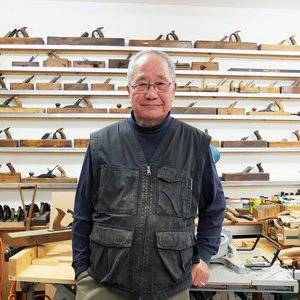
Born 1940, Tokyo, Japan
Kinji Akagawa is something of a Minnesota institution, respected as much for his forty-year teaching career at the Minneapolis College of Art and Design as his public art projects. He has brought humanism and generosity to both pursuits, undoubtedly one reason he received the prestigious McKnight Distinguished Artist Award in 2007. His projects are marked by the Japanese belief that even functional objects should be well crafted and “meaningful in the context and the content,”1 he says. Local materials are also important to him. Garden Seating, Reading, Thinking (1987, reinstalled 2017) at the Minneapolis Sculpture Garden uses basalt from nearby Taylors Falls, granite from South Dakota, and a slab of cedar. For a rain garden collaboration at Highpoint, he had a branch from the site cast in bronze and placed on his granite birdbath. As with nearly every project, he also created places to sit. “Seating becomes very much my sculptural language and aesthetic experience,” he says. “Seating encourages and fosters our thinking.”

Akagawa’s parents were barbers. He left his native Tokyo at age four with his mother and brother to escape the ravages of World War II. They stayed with an aunt in northern Japan, where Akagawa was surrounded by creative relatives: two blacksmiths, a lantern maker, a calligrapher, a painter.2 By 1946, when his family returned to Tokyo, their home and the barbershop had been destroyed. An American Episcopal priest and missionary, Richard A. Merritt, was very supportive of Akagawa, and in 1963—after the young artist finished at Kuwazawa Design School in Tokyo—Merritt paid his way to the United States on a cargo ship. He spent a summer at the Haystack Mountain School of Crafts in Maine, then enrolled at Cranbrook Academy of Art near Detroit. Just shy of graduation, he left to study printmaking at Tamarind Lithography Workshop in Los Angeles, supported by a Ford Foundation grant. Under master printer Kenneth Tyler he rose to senior printer, printing the work of fellow artists as well as his own . In 1967, Akagawa was hired at what is now the Minneapolis College of Art and Design. He initially taught printmaking, meanwhile earning his BFA (1968) there. He received an MFA (1969) from the University of Minnesota, Minneapolis, studying with the printmaker Zigmunds Priede. After brief teaching stints elsewhere, he settled in at MCAD, in 1973. Gradually, sculpture grew more dominant. Among his influences were artist Joseph Beuys, architect Alvar Aalto, and sculptors Constantin Brancusi, Isamu Noguchi, and Scott Burton.
Akagawa retired from MCAD in 2010. His public art includes The Enjoyment of Nature (1992) on Nicollet Mall and the Lyndale Park Peace Garden Bridge (2009), both in Minneapolis, as well as works in the Minnesota cities of Windom, Cambridge, St. Cloud, Grand Rapids, Thief River Falls, Bloomington, Lake Bronson, and more. He has received grants from the Minnesota State Arts Board (1995) and Carnegie Mellon Foundation (1984), and fellowships from the McKnight Foundation (1983) and Bush Foundation (1982). He was a visiting professor at Bauhaus University, Weimar, Germany (2004); University of Minnesota School of Architecture (2000); and Osaka University of Arts, Japan (1996); and a visiting artist at Tokyo Institute of Technology (2010–12). Akagawa lives in Afton, Minnesota, with his wife, the fiber artist Nancy Gipple.
—Marla J. Kinney
Notes
Kinji Akagawa, phone conversations with the author, May 2020. ↩︎
Mason Riddle, “Genius Loci: The Nest of a Finch,” in 2007 McKnight Distinguished Artist Kinji Akagawa (Minneapolis: McKnight Foundation, 2007), pp. 7–16, https://www.mcknight.org/wp-content/uploads/pdf-3-mb-1.pdf. ↩︎